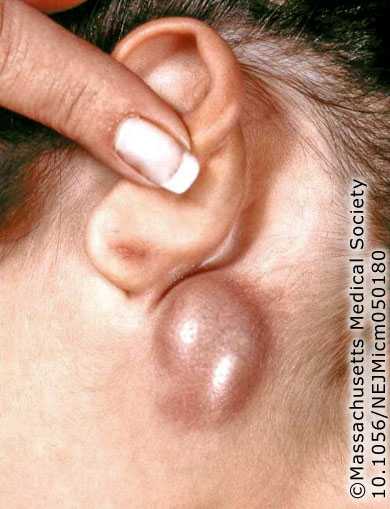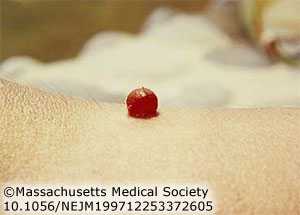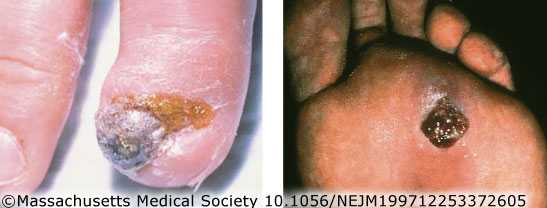Symptoms

Enlarged lymph node resulting from cat scratch disease. Used with permission of NEJM.
Cat scratch disease (CSD), Bartonella henselae
- Low-grade fever may be present
- Enlarged, tender lymph nodes that develop 1–3 weeks after exposure
- A papule or pustule at the inoculation site
Rarely, unusual manifestations such as eye infections, severe muscle pain, or encephalitis may occur.
Trench fever, Bartonella quintana
- Fever (may present as a single bout of fever or bouts of recurrent fever)
- Headache
- Rash
- Bone pain, mainly in the shins, neck, and back
Carrión’s disease, Bartonella bacilliformis
This disease has 2 distinct phases:
- Oroya fever: During this phase, patients may present with fever, headache, muscle aches, abdominal pain, and severe anemia.
- Verruga peruana: During this later phase, lesions appear under the skin as nodular growths, then emerge from the skin as red-to-purple vascular lesions that are prone to ulceration and bleeding.

Verruga peruana, mular form. Used with permission of NEJM.
Other complications
Bacillary angiomatosis
Bacillary angiomatosis (caused by B. henselae or B. quintana) and bacillary peliosis (caused by B. henselae) occur primarily in immunocompromised people, such as those with advanced HIV infection. Bacillary angiomatosis may present as lesions in the skin, subcutaneous tissue, bone, or other organs. Bacillary peliosis causes vascular lesions in the liver and spleen.
Subacute endocarditis
Many Bartonella species can cause subacute endocarditis (infection of the heart valves), which is often culture negative.

Bacillary angiomatosis. Used with permission of NEJM.
- Page last reviewed: December 14, 2015
- Page last updated: December 14, 2015
- Content source:


 ShareCompartir
ShareCompartir